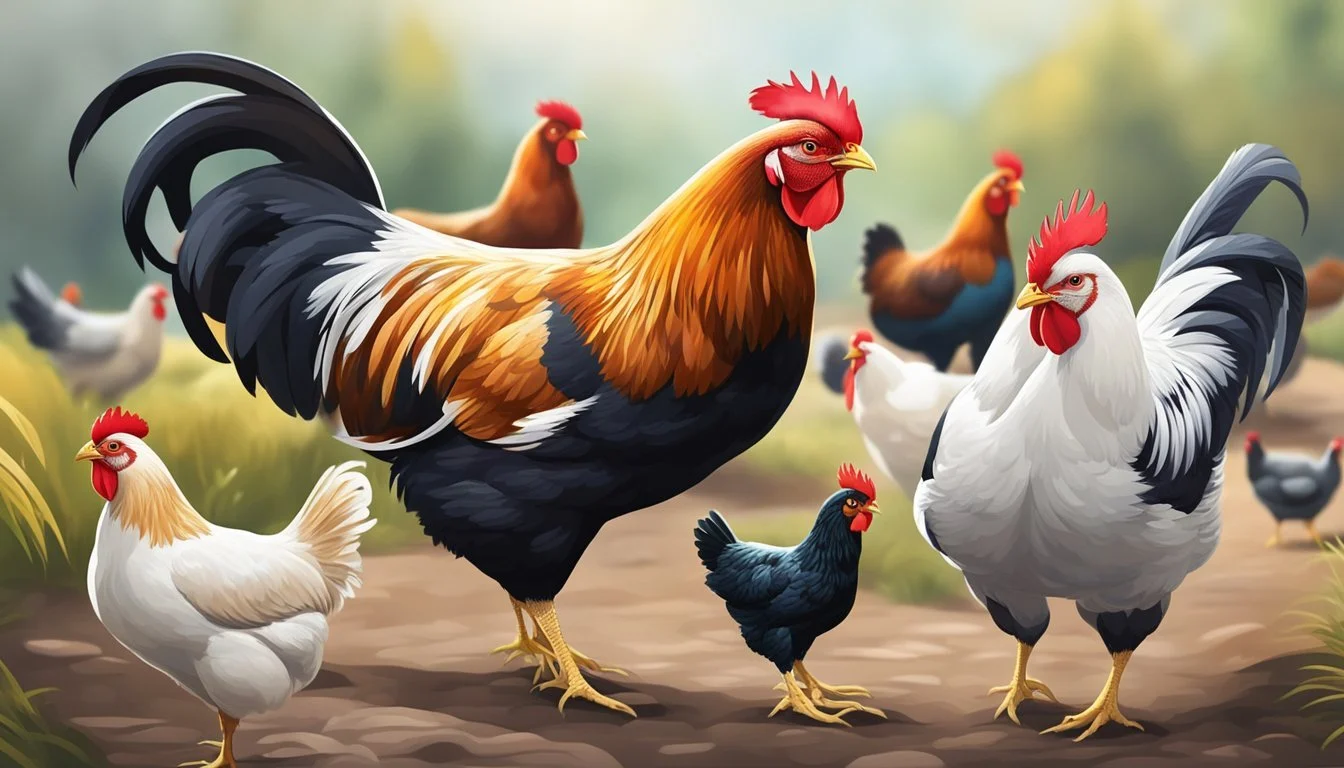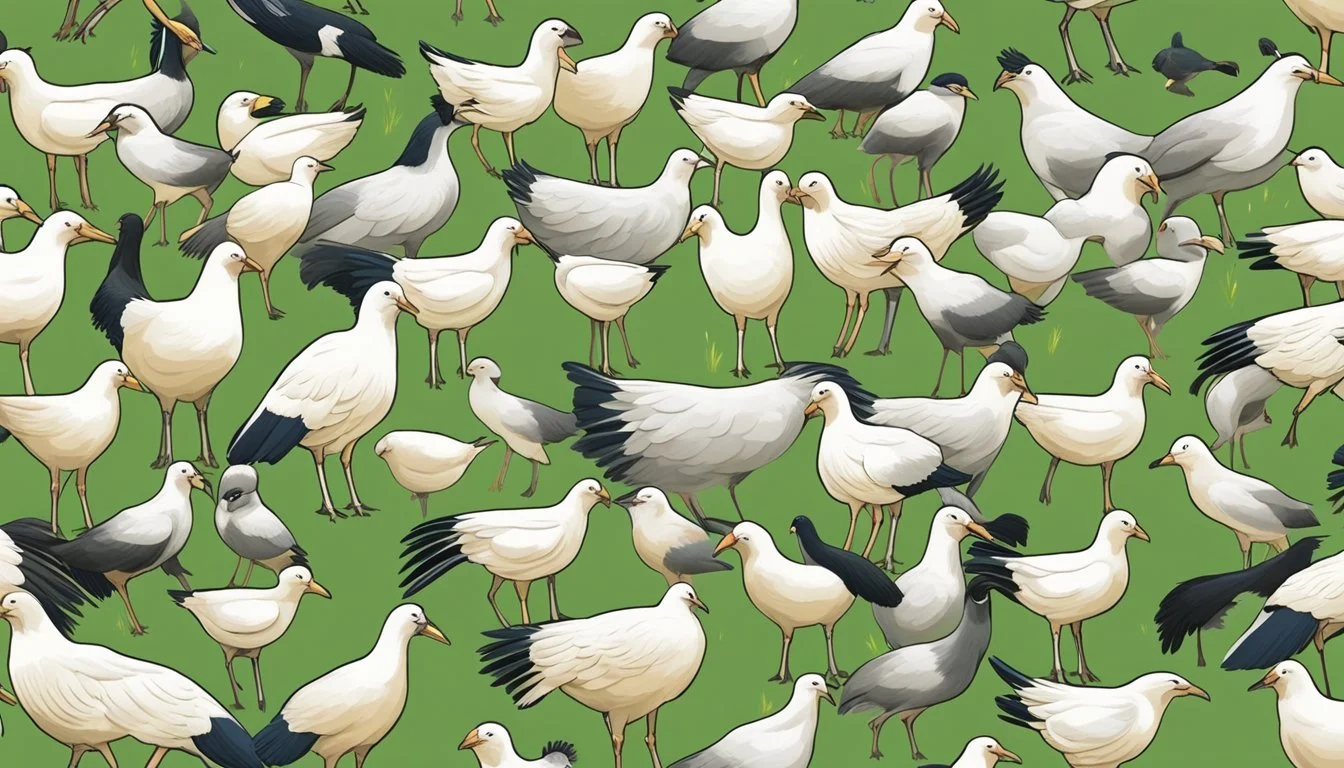How do I maintain genetic diversity in my flock?
Key Strategies for Sustainable Breeding
Maintaining genetic diversity within a poultry flock is essential for the health, productivity, and longevity of the birds. For farmers and backyard enthusiasts alike, a diverse gene pool ensures that the flock is less susceptible to disease, has better overall vigor, and can adapt to changing conditions. It involves a strategic approach to breeding, where selecting for specific traits and avoiding inbreeding are critical.
Breeding plans play a central role in sustaining genetic diversity. Such plans need clear goals and an understanding of the principles of genetics in poultry. To avoid or manage inbreeding, farmers may employ techniques like rotating breeding stock, using a clan mating system, or introducing new genetic material when necessary. Each method aims to maintain a healthy level of genetic variation without compromising the quality and characteristics of the flock.
Managers of breeding programs utilize tools like inbreeding coefficients and pedigrees to ensure genetic diversity is preserved. These methods help in making informed decisions about mating pairs, tracking lineage, and identifying potential genetic risks. By keeping a well-documented breeding history and remaining vigilant about the flock's genetic health, a sustainable and robust population of poultry can be achieved.
Understanding Genetic Diversity
Genetic diversity is the cornerstone of a healthy and robust flock, with implications for disease resistance, productivity, and long-term viability. It is a measure of the unique characteristics present within the genetic makeup of a breeding population.
Basics of Genetic Diversity
Genetic diversity refers to the total number of genetic characteristics in the genetic makeup of a species. It ensures that a population can adapt to changes in the environment and withstand diseases. When a flock possesses a wide range of genetic traits, it has a better chance of containing individuals who can survive and thrive under different conditions.
Benefits of Maintaining Diversity
Maintaining a diverse genetic pool in a chicken flock is crucial for several reasons. Disease resistance: Diverse genetic traits can provide immunity to a range of diseases. Productivity: Genetic variation often leads to individuals with superior production traits. Adaptability: Biodiversity within a flock means a greater ability to adapt to environmental changes.
Inbreeding and Its Effects
Inbreeding occurs when closely related individuals breed. This can lead to inbreeding depression, which is a reduction in fitness and vigor of a population due to the breeding of closely related individuals. The effects of inbreeding can be detrimental, including an increased prevalence of genetic defects and diseases, reduced fertility, and decreased resistance to environmental stressors. It is important to implement breeding strategies that minimize the risk of inbreeding to maintain a healthy flock.
Setting Goals for Breeding Programs
When shaping the future of a flock through a breeding program, defining precise goals is crucial. These will navigate decisions that influence both production and conservation, impacting the viability and genetic health of the flock.
Production vs. Conservation
In the realm of poultry breeding, it's critical to balance production attributes with conservation of genetic diversity. A breeding program may prioritize characteristics such as egg production, growth rate, or meat quality. However, maintaining genetic diversity is imperative to the flock's long-term resilience and adaptability to environmental changes. Programs aimed at conservation breeding often focus on heritage breeds, preserving their unique traits and minimizing inbreeding.
Example Production Goals:
Increase average egg production per hen to 300 eggs/year
Achieve an average weight of 2 kg for broilers at 8 weeks of age
Example Conservation Goals:
Sustain the existing gene pool of a rare breed
Enhance the breed's natural disease resistance
Establishing Clear Objectives
A breeding program must set clear and attainable objectives to track progress effectively. Goals should be specific, measurable, achievable, relevant, and time-bound (SMART). If the focus is on conservation, identify the particular traits or genetic markers needing preservation. If enhancing production, delineate the target metrics for performance.
Conservation Objective:
Retain at least 95% of the genetic markers identified as unique to the breed within the next five years.
Production Objective:
Increase flock egg-laying efficiency by 20% over the next three years without compromising bird health or welfare.
By defining these objectives, one can create a structured road map for the breeding program, leading to more successful and sustainable outcomes for both production-oriented and conservation-focused endeavors.
Choosing the Right Breeding Strategies
To sustain genetic diversity in a flock, it is crucial to choose effective breeding strategies. Such strategies help maintain a healthy genetic makeup and prevent genetic bottlenecks that can lead to decreased vitality and productivity.
Selective Breeding Practices
Selective breeding involves choosing specific breeding pairs with desired traits to pass down to offspring. Careful selection can help preserve or enhance genetic diversity within a flock. Breeders should evaluate the genotype and phenotype of each potential parent to ensure a diverse gene pool is maintained.
Implementing a Clan Mating System
A clan mating system divides the flock into separate family groups, or clans, each with its own set of males and females for reproduction. New bloodlines are introduced strategically to prevent inbreeding. The system allows for careful monitoring of genetic variation and is an effective way to manage genetic diversity over multiple generations.
Advantages of Cross-Breeding
Cross-breeding involves mating individuals from different breeds or strains. This can introduce new bloodlines and valuable genetic traits into a flock. Benefits include improved vigor, productivity, and often, enhanced resistance to disease, aiding the long-term sustainability of the flock.
Linebreeding Techniques
Linebreeding is a controlled method of breeding closely related animals to solidify desirable traits while still maintaining genetic diversity. It requires a knowledgeable balance, as too close linebreeding might increase the risk of inherited disorders, reducing overall genetic diversity. The focus remains on maintaining a robust flock through careful and planned reproduction practices.
Managing Your Flock's Gene Pool
Maintaining a healthy gene pool requires strategic management, including introducing new bloodlines, culling for genetic strength, and diligent record-keeping for effective genetic analysis. These steps help preserve genetic diversity, guarding against disease and ensuring adherence to breed standards.
Incorporating New Bloodlines
To maintain genetic diversity within a flock, breeders should consider introducing new bloodlines periodically. This doesn't mean random selection; instead, choose birds from reputable sources that complement the existing flock's traits. By carefully selecting and integrating birds from different bloodlines or breeds, one can avoid inbreeding and the associated health issues. Selecting from breeders who adhere to breed standards helps ensure the quality and vitality of offspring.
Culling for Genetic Health
Culling is not just about removing the weakest; it's a practice aimed at enhancing overall flock health and stability. By removing individuals that display significant genetic defects or poor health, a breeder effectively reduces the spread of undesirable traits and potential sources of disease. Culling decisions should be made with a clear understanding of heredity and the impact on the flock's future genetic makeup.
Genetic Analysis and Record Keeping
Detailed record keeping and genetic analysis are vital for maintaining diversity over generations. Through careful documentation of each bird's lineage, traits, and health, breeders can make informed breeding choices. These records can help identify which birds to breed together to preserve favorable traits or improve upon certain aspects, in line with the flock's genetic diversity goals. Advanced genetic analysis may even be employed to ascertain the genetic diversity of a flock scientifically, though this might be more typical in larger or more specialized breeding operations.
Breeding for Specific Traits
Breeding for specific traits in poultry involves a systematic approach that targets desired characteristics, such as plumage, temperament, or disease resistance. Selective breeding helps in preserving or enhancing these traits in a flock.
Desirable Qualities in Poultry
When considering desirable qualities in poultry, breeders look for traits that improve the flock's value and productivity. These qualities often include improved temperament, desirable plumage colors, and the ability to thrive in specific environments. A well-thought-out breeding plan ensures that these qualities are sustained or improved upon in each generation.
Heritage vs. Commercial Breeds
Heritage breeds are traditional livestock breeds that were prevalent before industrial farming practices became the norm. These breeds often retain a diverse genetic makeup and are valued for their resilience and adaptability to natural conditions. Contrastingly, commercial breeds are optimized for high production but may lack genetic diversity. Combining traits from both can result in a more robust and sustainable flock.
Selection for Resistance to Diseases
One of the key components in a breeding plan is the selection for resistance to diseases. By choosing individuals with strong immunity traits for breeding, one can incrementally enhance the disease resistance of the entire flock. This not only promotes animal welfare but also minimizes the reliance on medical interventions.
Breed Standards and Traits
Following breed standards can help maintain the genetic identity of heritage and rare breeds. Breeders may choose to focus on specific breed standards such as body shape, size, and colors. These standards help in preserving the distinct characteristics of each breed of chicken, which might include unique temperament or plumage patterns.
Through careful planning and selection, breeders can successfully enhance and maintain desirable traits within their flocks, contributing to the health, productivity, and sustainability of their poultry breeds.
Optimizing Living Environments for Genetic Health
Creating optimal living environments for genetic health involves managing various factors that can affect the wellbeing of livestock. These factors include pasture access, pest and parasite control, shelter and space, and climate considerations, each playing a crucial role in maintaining genetic diversity.
Impact of Pasture Access
Providing ample pasture access is essential for promoting genetic health. Livestock, when allowed to roam and graze, exhibit natural behaviors that are beneficial to their wellbeing. A diverse and rich pasture not only supplies necessary nutrients through a variety of grass and other plant species but also encourages physical activity that supports robust health and vitality.
Controlling Pests and Parasites
Effective pest and parasite control is vital for a healthy genetic stock. Livestock are susceptible to a range of parasites that can affect their growth, reproduction, and overall health, potentially leading to reduced genetic diversity. Regular health checks and management plans are crucial, as they help identify and mitigate the impact of these harmful organisms on the flock.
Shelter and Space Requirements
Shelter plays an imperative role in defending against environmental stressors and providing a safe retreat for rest and recovery. Adequate space is equally important, as overcrowding can lead to stress, disease spread, and aggressive behavior, all of which can harm genetic health. A well-designed chicken coop or barn should provide sufficient room for the livestock to interact and express natural behaviors without conflict.
Climate Considerations
Climate can significantly influence the genetic health of livestock. Animals that are adapted to specific environments may suffer if those conditions change drastically. It's essential to understand the local climate patterns and integrate adaptive measures for extreme weather, such as insulating shelters against cold and providing shaded areas during hot weather for free-range livestock. These considerations help ensure that livestock can thrive genetically in various climate conditions.
Practical Flock Management
Maintaining genetic diversity in a flock involves strategic feeding, careful monitoring of fertility and reproduction, managing the natural brooding instincts of hens, and understanding lifecycle and growth rate factors. Each of these aspects contributes to the overall health and vigor of the chickens, ensuring robust egg production and quality meat yield while managing feed costs.
Feeding for Optimal Genetics
The feeding regimen one provides directly affects the genetic potential of the flock. By offering a balanced diet rich in essential nutrients, breeders can promote robust fertility and strong eggshells, which are crucial for successful reproduction.
Optimal protein levels are necessary for both hens and roosters to support egg and sperm quality.
A varied diet with adequate vitamins and minerals supports the immune system and overall health.
Accessibility to feeders and waterers must be ensured to accommodate the flock's needs without inducing unnecessary stress.
Monitoring Fertility and Reproduction
Accurate record-keeping and observation are key in managing a flock's genetics. Breeders should track:
The fertility rates of eggs, monitoring the number of fertile eggs produced by each hen.
Egg production cycles to adjust breeding schedules for maximum efficacy.
Routine checks on the rooster's health and fertility status ensure that he is capable of consistently fertilizing eggs.
Managing Broodiness in Hens
Broodiness, while a natural behavior, can disrupt egg production schedules and affect feed costs. Breeders manage broody hens by:
Isolating broody hens temporarily to break the cycle.
Ensuring that nests are clear of eggs to discourage the instinct.
This allows for stable egg production and the choice to incubate select eggs for controlled genetic distribution.
Lifecycle and Growth Rate Considerations
A chicken's growth rate can influence meat production and longevity within the flock. Breeders should:
Selectively breed from chickens that exhibit desirable growth rates and robust health.
Monitor the development of chicks and juveniles for normal growth patterns.
Analysis of growth rate data helps in making informed decisions about breeding pairs and culling to maintain a genetically diverse and productive flock.
Exploring Equipment and Tools
Maintaining genetic diversity in a flock requires not just good breeding practices but also the right equipment to ensure the birds' health and well-being. Strategically selected tools can also play a crucial role in managing the environment and habitat of the flock.
Selecting Feeders and Waterers
When choosing feeders and waterers, it's essential to consider the size and layout of the flock's habitat. The right feeder should accommodate the number of birds without causing overcrowding, which can lead to competition and stress. It's critical to use feeders that provide adequate space and ensure equitable food access to all birds. Similarly, waterers must be easily accessible and kept clean to prevent the spread of diseases, supporting a healthy genetic pool by reducing health-related selective pressures.
Benefits of Using a Chicken Tractor
A chicken tractor is a mobile chicken coop without a floor. This equipment allows for frequent relocation of the flock to fresh ground, promoting a healthier living environment and access to a variety of natural nutrients. Additionally, it helps manage breeding by controlling which birds have access to specific areas of the land, thus aiding in maintaining genetic diversity.
Importance of Rakes and Other Tools
Proper maintenance of the living space is just as crucial as the genetic management of the flock. Tools such as rakes are necessary for cleaning and preparing bedding areas. Regular upkeep ensures a hygienic habitat, reduces the risk of disease, and aids in the observation of breeding patterns. Other tools like egg collection baskets and cleaning equipment support daily management tasks, ultimately contributing to the broader goal of fostering a diverse and robust flock.
Fostering a Self-Sustaining Flock
Achieving a self-sustaining flock requires a robust understanding of genetic principles and a commitment to education within the agricultural community.
Principles of Self-Sustainability
In the context of poultry farming, self-sustainability refers to a flock's ability to maintain production and health through its own genetic resources. Selective breeding is crucial; one must choose hens and roosters carefully to ensure a broad genetic base. For example, cross-breeding heritage chicken breeds like Buff Orpingtons, Rhode Island Reds, and Jersey Giants can combine desirable traits and preserve genetic diversity. It’s also important to properly manage the flock to prevent inbreeding, which might involve introducing new stock from other breeders or rotating breeding pairs. Detailed records of lineage and traits help farmers make informed decisions and support the health of future generations.
Educating Future Breeders and Farmers
Education is foundational in perpetuating self-sufficient and genetically diverse flocks. Breeders and farmers benefit from knowing how to select chickens for breeding based on vigor, resistance to disease, and other desirable characteristics. Workshops and online resources can cover topics such as heritage breed characteristics, and understanding the significance of genetic diversity. Networking with experienced breeders allows for the exchange of breeding stock, which supports genetic variety. By fostering an educational environment, the community ensures its long-term success and sustainability.







